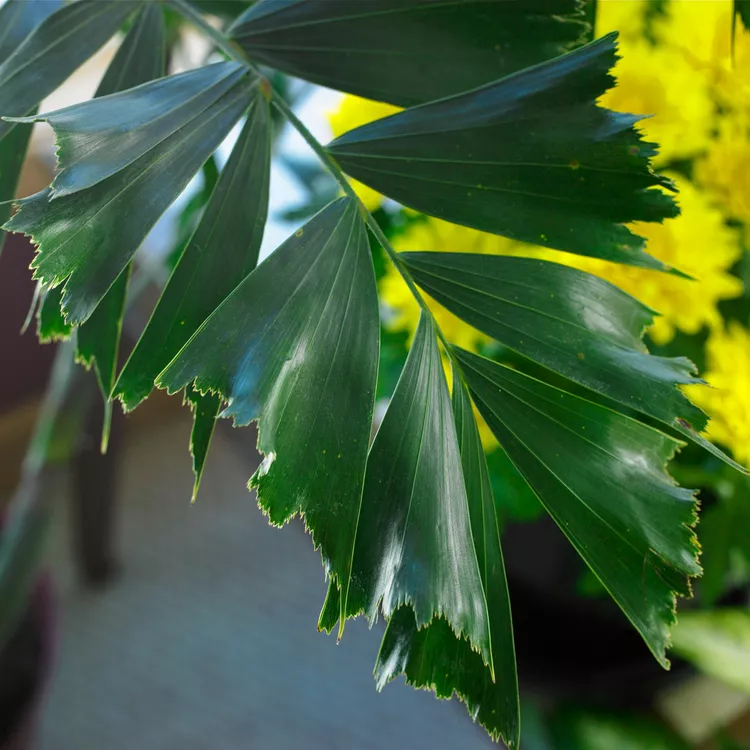Fishtail palm trees feature compound leaves that reach large sizes, as does the tree itself. Each leaflet on the enormous fronds feature ragged edges that resemble the tails of fish. Whether you grow this tree indoors as a houseplant or outside on a seasonal basis (or permanently in Zones 9-11), it adds a tropical touch wherever you grow it.
Worth noting: Most varieties of clump-forming fishtail palm trees are good outdoor substitutes for invasive bamboo (the world's fastest-growing plants).
Fishtail palms are toxic to dogs, cats, and people because they contain calcium oxalate crystals.
Fishtail Palm Overview
| Genus Name | Caryota sp. |
| Common Name | Fishtail Palm |
| Plant Type | Houseplant, Tree |
| Light | Part Sun, Sun |
| Height | 8 to 20 feet |
| Width | 10 to 35 feet |
| Foliage Color | Blue/Green |
| Special Features | Low Maintenance |
| Zones | 10, 11, 9 |
| Propagation | Seed |
| Problem Solvers | Drought Tolerant |
Where to Plant Fishtail Palm
Fishtail palm trees are tricky to grow as houseplants. The biggest limiting factor is the tree's ultimate size. Even smaller species can reach 20 feet tall, so any specimen will likely outgrow its space. If you decide to give it a go, plant the tree in a pot with enough room to accommodate its growth. These trees are tough and slow-growing, so even in less-than-ideal conditions, your specimen will survive. It will decline over time, however.
Fishtail Palm Care Tips
Light
Light is a limiting factor when growing fishtail palms because most indoor lighting can't equal the bright light these trees need to thrive. In the outdoors, they grow amidst taller trees that help filter out the light and heat, so plant them in a sunny spot that gets morning sun and less direct light later in the day.
Soil and Water
Use a cactus soil mix or a general-purpose potting mix with sand or perlite mixed in to create excellent drainage, because these trees like it on the drier side. Add water to fishtail palms whenever the soil feels dry to the touch, which you can test by sticking a finger in the soil about an inch deep. Damp soil means you don't need to water.
Temperature and Humidity
Fishtail palms are fussy about humidity and need at least 50% humidity to grow and stay healthy. Indoors, you can add a humidifier near the tree or place a tray of pebbles in water under its pot. Keep plants away from air vents or drafty areas. If your home is kept between 65ºF and 85ºF, your tree will do fine.
Fertilizer
During the fishtail's growing season, add fertilizer once a month after watering. At a minimum, give your tree a slow-release fertilizer every few months. Use fertilizer specifically for palm trees for best results.
Pruning
There's no need to prune fishtail palms. If you spot dead leaves, trim them off the tree. You can also prune if the tree is getting too large for your space. Trim the tops of leaves at the top of the tree to prevent it from growing taller.
Potting and Repotting Fishtail Palm
You'll know it's time to repot your fishtail palm when you spot roots growing out of drainage holes or the plant has completely filled the container. You shouldn't need to repot a fishtail palm more than every few years. Gently slide it out of its container and move it to one a size bigger. Don't go too big, or water will collect around the plant and cause damage.
Pests and Problems
Fishtail palms don't generally have pests. Problems are few, but if you see yellowing foliage, it means there's not enough humidity for your plant. If you see limp, wilting foliage, it means your soil is too wet and the plant may have root rot. In that case, try repotting with fresh soil and reducing the amount you water.
How to Propagate Fishtail Palm
If you have a suckering fishtail palm, it's easy to propagate through divisions. You'll need gloves, snips, a shovel, and a pot. (The pot size should match the size of the sucker and the length and number of its roots.)
Here's how to propagate your fishtail palm:
- Add well-draining soil to the bottom of the pot.
- Carefully remove the palm by gently pulling on it, or use the shovel for additional help.
- Shake the excess dirt off the roots so you can see them clearly.
- You should see a natural division between the mother plant and the suckers. Carefully pull and separate the plants. Use snips to cut through the roots if they're too tangled to unravel.
- Add each division to a separate container. Cover the roots with soil.
- Allow excess water to drain away after watering the plants.
Types of Fishtail Palm
Toddy fishtail palm
Caryota urens gets its name from the fact that sap from its flower is sometimes collected to make an alcoholic beverage or toddy. It is a large tree reaching 50 feet tall and forming a gray trunk up to 18 inches in diameter. Zones 10-11.
Giant fishtail palm
Caryota gigas is the largest of the fishtail palms, growing 70 feet tall. It will withstand temperatures to 28 degrees F and grows best where nights are cool. Giant fishtail palm lives 25-30 years. Zones 10-11.
Clumping fishtail palm
Caryota mitis grows 20 feet tall and 15 feet wide and prefers moist soil. It usually sends up multiple stems or trunks. It is sometimes grown indoors as a large houseplant. Once the plant begins to flower in the landscape, it dies over a two-year period, but seedlings often take the place of the dying stems. Zones 10-11.




















